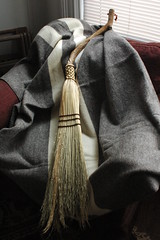 When I wrote about the Sheep & Wool Festival, I mentioned that we bought a broom, among other things. And in the comments, I mentioned that we also bought a blanket.
When I wrote about the Sheep & Wool Festival, I mentioned that we bought a broom, among other things. And in the comments, I mentioned that we also bought a blanket.
Here they are.
For the past three years, the Sheep & Wool Festival has issued a limited edition blanket commissioned and designed just for the festival. They had one blanket left from 2005 and I much preferred it over this year’s design because of the stripes. It’s a throw blanket, not big enough for enough a small bed. It’s wonderfully light, soft and warm.
A certificate came with the blanket as well. I tried to scan it to include here, but can’t get that to work today for some reason. It reads:
The Hudson Valley Blanket
Series 2: Number 001
This limited edition blanket has been created using wool grown in the Hudson River Valley. It is the result of a joint project between The Chas. W. House & Sons, Inc. woolen mill and New York State’s Hudson Valley sheep producers. The Hudson River Valley is bordered by the scenic Catskill Mountains to the West and the Berkshires to the East. This is depicted in the blanket design with naturally colored stripes.
The following flocks have contributed wool to this blanket:
Mary Godesky, Red Hook, NY
Jessi & Ethan Page, Salt Point, NY
North Breeze Farm, Millbrook, NY
Wild Apple Farm Ltd., Hudson, NY
Jeff & Debbie Traver, Pleasant Valley, NY
Shepherds Garden, Clermont, NY[I’ve elided the phone numbers of the growers for their privacy.]
The wool in this Hudson Valley blanket consists of fleeces from Corriedale, Dorset, Columbia, Hampshire and Merino sheep. The employees of Chas. W. House & Sons, Inc. and the Hudson Valley sheep producers hope you will enjoy this quality wool product for many years.
I remembered that the “art” brooms were called plaited brooms because of the way the stems were attached to the handle:
The stems are partially split and plaited all around the handle. The dried stems are used in their natural form, untrimmed. You can even see some seedheads still left on the ends of the stems:
The handle itself is a natural form. This was the most bent one of all those on display. I actually liked it the most. It looks like a classic witch’s broom. It may make an appearance this Halloween!
All the handles of the plaited brooms were carved. Each had a different design. This was the only one which also had ant tunnels on it. Again, I liked that difference this handle had from all the others. It’s a unique piece of hand-work.
- Previous: #8 Yarn and Stuff
- Table of Contents






I would not have thought that I’d think a broom and blanket were so interesting until you posted the photo.
Both look like remarkable treasures. I could use a few blankets like that… though I’m CERTAIN they are quite expensive. (It appears to be worth it.)
If I recall correctly, the blanket was $80. That seemed reasonable for the quality and provenance. It will last forever.
The carved-handle plaited brooms were all $40, the most expensive type they had. (You can see how this adds up quickly! That’s why I budgeted myself …)
A full-sized regular flat-head broom was $17, I think. They designed and made several tyes of brooms for different purposes, based on the types and coarseness of bristles, shapes of heads, lengths of handles, and so on.
Oh wow… beautiful photos of two gorgeous handmade items. I love that wool blanket with the two white stripes–very appropriate taste of the traditional trader’s blankets, given the sources.
I only wish that we had similar festivals around here. Hmm, maybe we do and I just haven’t found one yet…